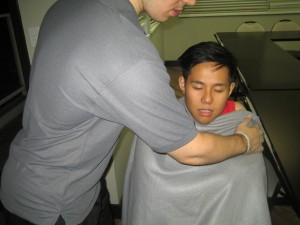Frostbite is the condition of the skin caused due to freezing of the skin when it is exposed to very cold temperatures. It often starts with mild symptoms and can eventually progress to a severe, limb-threatening condition. Frostbite is considered mild when it is either red or painful or is white and numb. In case of severe frostbite, there is blistering of the skin or occurrence of hardened skin due to frozen bones and blood vessels is also seen.

There is also possibility of gangrene in which the blood vessel freezes, tissue of the body dies and turns black. Frostbite and hypothermia are often linked.
First Aid Guide:
For mild frost bite, the following first aid guide measures are suggested:
- Firstly move the person to a place that is warmer.
- Remove clothing from the area that is affected.
- Rewarm the affected area until the sensation has returned to it. Please not that rewarming to frost bitten skin is often accompanied by pain, swelling and color change.
- In order to rewarm the frost bitten area, place it in a bath of warm water. For areas of the body that cannot be submerged in water, apply warm compresses to it.
- Application of clean, sterile and dry dressing is also recommended. Re-cover the area to keep it warm.
- Seek medical help.
You should keep in mind that frost bitten areas once thawed, should not be moved much. Also, you should not massage the affected area in order to rewarm it. Do not disturb any blisters or skin that has become gangrenous. Don’t use any high heat products like hair dryers, heating pads, etc. to rewarm frost bitten areas.
In the eventuality of a person affected by both frostbite and hypothermia, the later should be treated first. While medical help is on its way, carry out the following checks on the person, open the airway; check the breathing and circulation. Move the person to warmer area and remove any wet and restrictive clothing. Cover the person with a warm blanket and apply warm compresses to the body.
Who’s At Risk?
Frostbite can occur to people to are exposed to extremely cold temperatures like people participating in outdoor activities involving very cold weather. It can also occur to people exposed to high winds or have poor circulation and suffer from fatigue.
Signs and Symptoms
The most common parts of the body that are affected by it are the parts of the exposed to extreme cold such as face or ears, and other parts like fingers and toes. When the skin is mildly frost bitten, it will look either white or reddened. In severe cases, the skin looks blistered, very often blackened and is hard to touch.
One should seek medical help for any form of frost bite. Emergency medical help should be sought in severe cases. Your doctor will work to rewarm the frost bitten areas. He can also give you pain killers to help you manage the pain associated with it. In case of infection antibiotics can also be prescribed and in more severe cases surgical intervention may be necessary.
